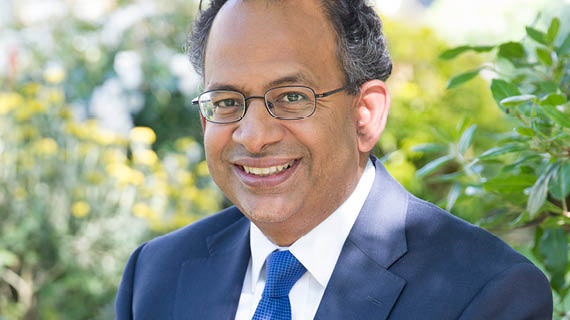A Quick Q&A on the REF With Its Creator
Think of a researcher measuring the trajectory of a laser beam in a university physics lab or a history professor digging through a church’s long-lost archives and their work can often feel far removed from life’s daily reality. But as the amount of funding the government is able to spend on research comes under pressure, so pressure is mounting on academics to show the impact of their work on the real world.
On December 18, universities and their staff will be keenly analysing data published in the Research Excellence Framework (REF), a national review of university research. For the first time, university research will be judged on its impact outside the world of academia. These results will later be used to inform how much research funding different universities receive.
The Conversation asked the man who developed the REF back in 2008, Rama Thirunamachandran, vice-chancellor and principal at Canterbury Christ Church University, to talk us through it.
Why is the REF so important?
A significant amount of public funding goes into research, so government quite understandably needs to ensure that the research coming out of this significant investment is of high quality.
Since 1986 there has been a national review of research done roughly every five or six years. It was initially called the Research Selectivity Exercise, then in 1992 it became the Research Assessment Exercise (RAE) and in 2008 it became the Research Excellence Framework. The purpose is to assess the quality of research going on in universities through a profile of each subject area. These assessment profiles will then inform the amount of public funding going to subject areas at different universities.

This talk with Rama Thirunamachandran originally appeared at The Conversation, a Social Science Space partner site, under the title “Q&A: what is the REF and how is the quality of university research measured?”
The important addition this year is the assessment of the impact of research. Panels of peer-reviewers assess the research submitted by universities for how much impact it has had on the real world.
How is it measured?
Research outputs, such as research publications, amount for 65 percent of the profile, impact is 20% and the research environment, which includes staff development and training of postgraduate researchers, counts for 15 percent of the overall quality profile. It is not individual academics who receive a rating, but the research subject area at a particular university. They will be given a starred level from one (the lowest) to four (highest), or listed as unclassified if the quality falls below the standard of nationally recognised research.
In the past, the results have shown a concentration of research excellence at a few universities. Will we see that same pattern this year?
The shift in the REF after the 2008 RAE, which I was responsible for, towards assessing universities through quality profiles allowed the system to identify pockets of excellence across a very wide range of universities. Each university has some pockets of excellence. But the majority of very high-quality research, defined as three star and four star – research which is world-leading, or research which is internationally excellent – is found in probably 20 or so universities in the country. But it’s important to note that the UK’s other universities do have a significant amount of research capability, some of which is internationally excellent.
What relation does the REF have to university funding?
The funding calculations don’t happen until the spring by the Higher Education Funding Council for England (HEFCE). Universities won’t know the funding implications when the REF results are announced. If their results are better than last time round, and better than the average improvement in the sector, they might possibly infer there might be a bit more money coming into their particular university.
But university research funding [in England] is dependent on how much money government provides for research to the Higher Education Funding Council for England (HEFCE) and that won’t be known until the new year. There is a fixed pot of money for research which will go from the government to HEFCE and then HEFCE will develop a formula to allocate those limited resources using the REF results.
HEFCE always gives highest priority to the highest rated research. Four-star rated quality research will get the highest levels of funding and three-star the next highest levels of funding. It’s likely that no other funding will be available for research rated as two star, one star and unclassified, simply because there probably isn’t enough funding.
How useful is the REF for students and potential students?
There is clearly a connection between research and teaching, so I’d like to think most academics who are teachers are also involved in research in some way. Not all of them will be involved in research of the quality which will get them submitted to the REF and there are many other factors which affect the quality of teaching and the experience students receive.
Some of the universities which are less-research intensive are the universities which are very focused on the quality of their education and the student experience. Just looking at the REF results is not hugely helpful to a potential applicant. It says something about the quality of research in that unit, or that university, but it doesn’t really tell you anything about the quality of education, the nature of the curriculum, the amount of teaching hours and contact hours that students have.
But at postgraduate level, particularly for postgraduate research students, I think that the stronger research units provide a very good quality research environment for them to succeed and thrive.
What are the key things to look out for in this year’s REF results?
One interesting thing to see will be to look out for the pockets of excellence from 2008 and see whether they have been maintained. The other would be how the subject assessment panels have assessed impact and how this has played into the overall assessment of each unit.
Is the way the UK assesses research different from other countries?
We were probably the pioneers of this type of exercise, way back in the mid 1980s. Undoubtedly, some of the countries whose higher education is modelled on the UK system, such as Australia and Hong Kong, have modelled their research systems on very similar lines. But then there are very successful research systems in countries such as the US, where there isn’t anything comparable with this and assessment and peer review happens at different levels.![]()




















































































